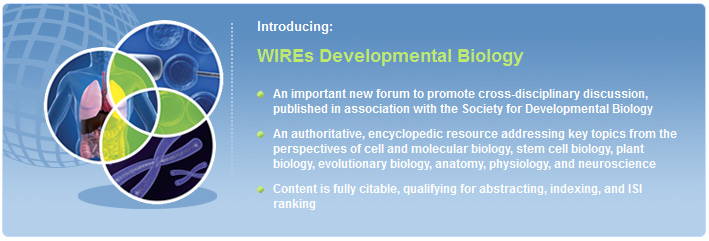New Community Resource: WIREs Developmental Biology
Posted by Marsha Lucas, on 1 March 2012
The Society for Developmental Biology (SDB) has partnered with Wiley-Blackwell to publish a new web-based encyclopedic resource for developmental biologists—WIREs Developmental Biology. This collection of invited peer-reviewed review articles encompasses the vast field of developmental biology with content chosen by an expert team of editors. It is an online-only publication open to all for its first two years of publication and thereafter to subscribers and SDB members.
 The Editors-in-Chief are three outstanding developmental biologists: John C. Gerhart (University of California, Berkeley), Gail R. Martin (University of California, San Francisco), and Eric F. Wieschaus (Princeton University).
The Editors-in-Chief are three outstanding developmental biologists: John C. Gerhart (University of California, Berkeley), Gail R. Martin (University of California, San Francisco), and Eric F. Wieschaus (Princeton University).
In an announcement in the Winter 2012 issue of SDB e-news, Gerhart said, “WIREs Developmental Biology offers a dynamic and integrated approach to its encyclopedic coverage of the field exposing the interconnectivity of developmental processes.” Describing the projects origins he said, “This venture grew from conversations held in the Society [SDB] well over a decade ago regarding the need for an authoritative discipline-encompassing publication” that was “updateable and interactive.”
WIREs articles can be browsed either by topic or issue. The WIREs model takes advantage of the web platform with embedded links within articles out to scientific databases and other relevant sites. Additionally, under the “Resources” tab readers can find further reading, videos, and links to our companion learning resources at SDB CoRe (see Node article here). As the field grows, content will continue to be expanded and existing articles updated. There are also opportunities for community interaction through article comments.
Go ahead and dive into the content at WIREs Developmental Biology. Patterning, organogenesis, stem cells, and evolution are just a few of the topics. A range of organisms are represented including plants, worms, frogs, flies, and even humans. Take advantage of this new encyclopedic resource for your teaching needs and your own enrichment in the field of developmental biology.


 (6 votes)
(6 votes)